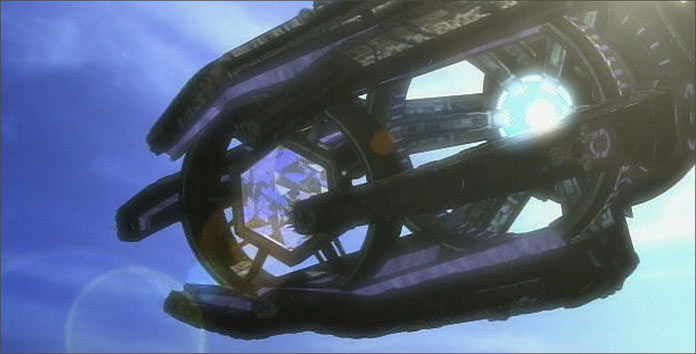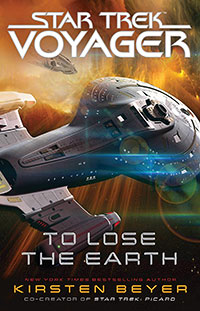Eleven years after Full Circle — the start of Kirsten Beyer’s ten-book Star Trek: Voyager relaunch — the long-running series finally comes to an end with To Lose the Earth, closing yet another chapter in the last two decades of Star Trek novel continuity.
To Lose the Earth is a beautiful conclusion to the Voyager relaunch. Rather than inspiring an air of finality in its final pages, it creates a sense of new beginnings, and leaves you satisfied with the conclusion of the character arcs started in Full Circle… but aching at the same time for the untold stories that will never follow.
Kirsten Beyer’s career is the ultimate Star Trek fan success story: with the popularity of her Voyager books as a launchpad, Beyer landed a position in the Star Trek: Discovery writers room and has gone on to earn herself a co-creator and co-executive producer title on Star Trek: Picard. Her accolades are well earned, and the Voyager relaunch is probably one of the most exquisite series of Star Trek novels ever published.
Beyer’s books, taken as a whole, expand the Star Trek universe in new and interesting ways, revisit familiar species from the Delta Quadrant with new twists, serve up some truly creative and unique aliens, all while grounded in Voyager’s characters — both new and old. By the end of these ten books, you’ll care just as much about Janeway, Chakotay, and the television Voyager crew as you’ll care about many of the characters created for the relaunch — like Counselor Hugh Cambridge, Lieutenant Devi Patel, Commander Liam O’Donnell, and Captain Regina Farkas.
It’s important to note that this book is set within the “old” continuity — Seven of Nine’s story is very different in the post-series Voyager novels than as depicted in Star Trek: Picard, and it’s expected that Janeway’s time in Star Trek: Prodigy won’t reflect any of the events of the book series.

To Lose the Earth is a direct sequel to 2018’s Architects of Infinity, picking up immediately after the USS Galen, one of Voyager’s companion ships, appears to have been destroyed. Aboard were Lt. Harry Kim, Reg Barclay, the Doctor, and a number of important characters in the books such as Voyager’s new Chief Engineer, Nancy Conlon.
But instead of being destroyed, the Galen was in fact transported halfway across the galaxy by a powerful alien species: the Edrehmaia. The plot of the book involves Voyager’s investigation of the disappearance of the Galen, the Galen’s attempts to discern the intentions of the aliens who transported them, and a challenge to Admiral Janeway’s leadership of the Full Circle fleet from the Department of Temporal Investigations.
In To Lose the Earth, Beyer is juggling a large cast of characters — including each of the Voyager main cast (minus Tuvok, who transferred to the USS Titan years ago) as well as the novel original characters… and because this is the last book in the series, there is a lot to tie up.

Beyer effectively does so for most of the characters, closing this chapter of their lives and in some cases opening a new one. But with so many characters, there are plot threads that get shorter shrift than I would have necessarily liked, such as the relationship between Seven of Nine and Counselor Hugh Cambridge. But some of the character arcs — especially those for Harry Kim and the eccentric captain of the USS Demeter, Commander O’Donnell — are exquisitely handled.
If there’s one relationship that perhaps did not get the space to breathe it deserved in this book given how it ends, it’s the one between Admiral Janeway and Captain Chakotay, who have become involved romantically since Admiral Janeway was resurrected… it’s a long story. There are only a couple of scenes shared between the two that don’t directly relate to the plot at hand.
And given the ending — the marriage between Janeway and Chakotay — I would have liked a little more time for these two. However, given how central they have been to previous novels in the series, and how it would have detracted from the attention afforded characters like Harry Kim, it is understandable.

The Edrehmaia — an ancient and thoroughly alien species contacted by the Full Circle fleet following the events of Architects of Infinity — are a great concept. Beyer has had a lot of cool ideas in these novels that would never have been possible on a television budget (even a Kurtzman-era Star Trek budget) and the Edrehmaia are no different. Where first their intentions seem hostile, as the book develops we learn that they aren’t hostile, just so alien to us their agenda is a mystery.
By the end of the book, Voyager commits itself to help the Edrehmaia achieve their goal: allowing them to pass beyond the Great Barrier at the edge of the galaxy and into the void between galaxies to new frontiers. And Voyager agrees to accompany them on that journey to the next galaxy, beginning a journey even more fantastical than the one Voyager completed through the Delta Quadrant.
But where that voyage into the unknown was involuntary, Voyager’s trip where no one has gone before is entirely their own choice. To end the series with a new adventure, rather than a return home, is a hopeful and inspiring place to leave this group of explorers.

There is also one subplot that continues throughout the book that is left tantalizingly unresolved. Previous novels included a developing story around the Krenim Imperium (of “Year of Hell” fame) and possible ongoing shenanigans related to altering timelines.
Had Beyer not become a television writer and the Voyager novels continued, one suspects that later books may have explored that further. As it stands, the book ends with a conversation between the new leader of the Full Circle fleet, Captain Farkas, and Starfleet’s Commander in Chief. Admiral Leonard James Akaar, about the threat of the Krenim and the possibility they are continuing to manipulate time.
If one were searching — hypothetically — for a way to reconcile the continuity of the Star Trek novels with the continuity now developing on screen in the latest generation of Star Trek productions, a powerful enemy with the ability to manipulate time might play a role.
Who knows if that’s anywhere close to what Beyer intended, but fellow Star Trek novelists David Mack and Dayton Ward have hinted about wanting to find a way to give the novel continuity a proper send off, and maybe they enlisted Beyer’s help in the process. (Or perhaps I’m just reading too much into it!)

But if To Lose the Earth is the closest we get to a final send off to the 24th century novel continuity enjoyed by fans for almost two decades, as well as the final installment of the Voyager relaunch, you could not ask for better.
To Lose the Earth is an emotionally uplifting conclusion to this incredible series, and I am eagerly looking forward to re-reading the whole thing. Beyer is a master novelist, and I hope amidst her continued and growing success on television, she will have occasion to use her novelist skills again in the future.
I know I’ll be buying.

